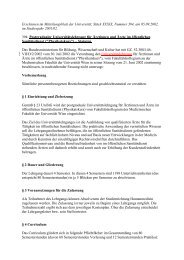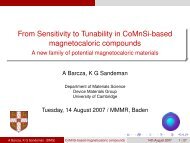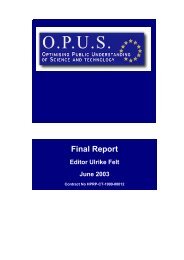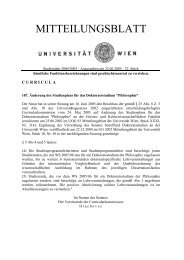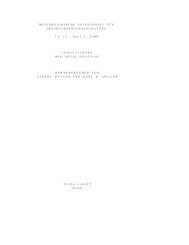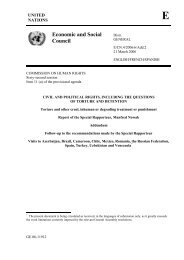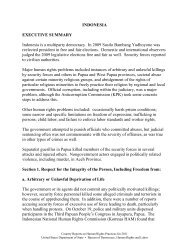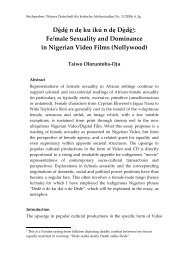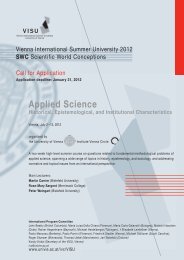(Stand: 25. Juli 2007) ANDERSON, Michael Alan ... - Universität Wien
(Stand: 25. Juli 2007) ANDERSON, Michael Alan ... - Universität Wien
(Stand: 25. Juli 2007) ANDERSON, Michael Alan ... - Universität Wien
You also want an ePaper? Increase the reach of your titles
YUMPU automatically turns print PDFs into web optimized ePapers that Google loves.
MEDIEVAL & RENAISSANCE MUSIC CONFERENCE <strong>2007</strong> – WIEN, 7.-11. AUGUST ABSTRACTS<br />
BINYAMINI, Raz (Musicology Department, Tel-Aviv University)<br />
Willaert’s “Musica Nova“ Reconsidered: Politics and the Arts in 16th-Century Venice<br />
Freitag/Friday, 10.8., 14.30 Uhr, KuGe, SR 1<br />
The paper reconsiders Willaert’s Musica Nova in the light of (1) the complex relationships<br />
between myth and reality in 16th-century Venice; (2) Bembism, with its Platonic and Petrarchan<br />
bias; and (3) Titian’s Venus paintings.<br />
The two salient features of Willaert’s Musica Nova – its unique juxtaposition of sacred<br />
motets and secular madrigals, and its novel application of motet-like texture – may be<br />
illuminated when viewed against the fundamental nexus of the divine and the secular,<br />
constitutive of both the Myth of Venice and Petrarch’s Canzoniere. Thus, Willaert’s elevation<br />
of the madrigal may be viewed not only as an attempt to match music with the high<br />
level of Petrarch’s poetics, but also as a subtle way of emblematizing a key point in Venetian<br />
myth. Examining Willaert’s manipulation of biblical texts and his choice of Petrarchan<br />
texts sheds further light on the relevance of the myth for understanding the composer’s<br />
work and on the latter’s own assessment of the myth considering the devastating<br />
political reality.<br />
Perusing Willaert’s Musica Nova in light of Bembo’s Gli Asolani and Titian’s Sacred<br />
and Profane Love reveals their conceptual affinity in grounding the relation between the<br />
terrestrial and the celestial in the philosophical-poetical concept of Platonic-Petrarchan<br />
Love, while revolving around Venus and the Virgin – the two feminine personae identified<br />
with Venice according to its myth. Furthermore, in its adaptation of the spiritual concept<br />
of the sonorous qualities of language, as formulated in Bembo’s Prose, Willaert’s musical<br />
idiom should be understood as a reaffirmation of the myth by assuring means for<br />
transcendence. This point is further supported when considering the spiritual elevation of<br />
speech and sound in comparison to the concreteness of sight – as reflected in Petrarch’s<br />
sonnets, in Bembo’s Gli Asolani, and in Titian’s Sacred and Profane Love and Venus and Cupid<br />
with a Lute Player.<br />
BOBETH, Gundela (<strong>Universität</strong> <strong>Wien</strong>)<br />
� �<br />
Die humanistische Odenkomposition im Spannungsfeld von Buchdruck und Handschrift:<br />
Zur Rolle der „Melopoiae“ bei der Formung und Ausbreitung eines kompositorischen<br />
Erfolgsmodells<br />
Mittwoch/Wednesday, 8.8., 16.00 Uhr, KuGe, SR 1<br />
Die 1507 von Erhard Öglin in Augsburg gedruckten Melopoiae sive harmoniae tetracenticae<br />
super xxii genera carminum …, von Petrus Tritonius nach den konzeptionellen Vorgaben des<br />
Conrad Celtis komponiert, gelten bis heute als Initialzündung, wenn es um die Verbreitung,<br />
Rezeption und Eigenproduktion humanistischer Odenkompositionen geht. Für die<br />
Vorbildhaftigkeit dieses Pionierdrucks sprechen nicht nur die Zahl der erweiterten Neuausgaben,<br />
die der Öglinsche Druck noch bis in die zweite Jahrhunderthälfte hinein erfuhr,<br />
sondern auch die offensichtlich von Tritonius inspirierten eigenen Kompositionen eines<br />
- 17 -




